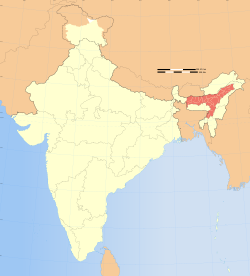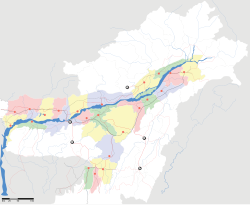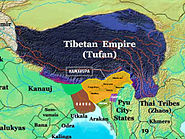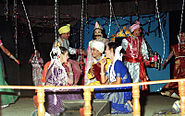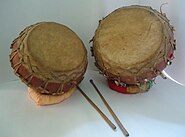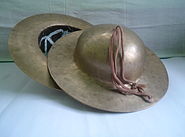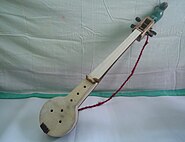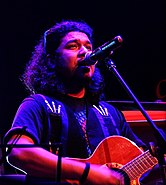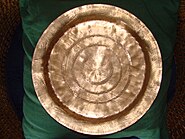| Assam অসম |
|||
|---|---|---|---|
| — State — | |||
|
|||
| Location of Assam in India | |||
| Map of Assam | |||
| Coordinates (Dispur): Coordinates: | |||
| Country | |||
| Region | Northeast India | ||
| Established | 15 August 1947 | ||
| Capital | Dispur | ||
| Largest city | Guwahati | ||
| Districts | 27 | ||
| Government[*] | |||
| • Governor | J B Patnaik | ||
| • Chief Minister | Tarun Gogoi (INC) | ||
| • Legislature | Unicameral (126 seats) | ||
| • Parliamentary constituency | 14 | ||
| • High Court | Gauhati High Court | ||
| Area | |||
| • Total | 78,550 km2 (30,330 sq mi) | ||
| Area rank | 16th | ||
| Population (2011) | |||
| • Total | 31,169,272 | ||
| • Rank | 14th | ||
| • Density | 400/km2 (1,000/sq mi) | ||
| Time zone | IST (UTC+05:30) | ||
| ISO 3166 code | IN-AS | ||
| HDI | |||
| HDI rank | 22nd (2005) | ||
| Literacy | 73.18% (26th)[1] | ||
| Official languages | Assamese; Karbi;[2] Bodo (in Bodoland)[3]; Bengali (in Barak Valley) | ||
| Website | assam.gov.in | ||
| ^[*] Assam has had a legislature since 1937 ^[*] Assam is one of the original provinces of British India | |||
Assam state ([æˈsæm]; Assamese: অসম) pronunciation (help·info) pronounced [ɔxɔm] is a northeastern state of India. Its capital is Dispur, located at Guwahati. Guwahati is also known as the North-Easte corridor of India. Located south of the eastern Himalayas, Assam comprises the Brahmaputra and the Barak river valleys along with the Karbi Anglong and the North Cachar Hills with an area of 30,285 square miles (78,438 km²). Assam is surrounded by six of the other Seven Sister States: Arunachal Pradesh, Nagaland, Manipur, Mizoram, Tripura and Meghalaya. These states are connected to the rest of India via a narrow strip in West Bengal called the Siliguri Corridor or "Chicken's Neck".[4] Assam also shares international borders with Bhutan and Bangladesh; and cultures, peoples and climate with South-East Asia – important elements in India’s Look East policy.[5]
Assam became a part of the British India after the British occupied the region following the First Anglo-Burmese War of 1824–1826. It is known for Assam tea, large and old petroleum resources, Assam silk and for its rich biodiversity. Assam has successfully conserved the one-horned Indian rhinoceros from near extinction, along with the tiger and numerous species of birds, and it provides one of the last wild habitats for the Asian elephant. It is becoming an increasingly popular destination for wildlife tourism, and Kaziranga and Manas are both World Heritage Sites.[6] Assam was also known for its Sal tree forests and forest products, much depleted now. A land of high rainfall, Assam is endowed with lush greenery and the mighty river Brahmaputra, whose tributaries and oxbow lakes provide the region with a unique hydro-geomorphic and aesthetic environment.
Etymology[]
The precise etymology of "Assam" in unknown. In the classical period and up to the 12th century the region east of the Karatoya river, largely congruent to present-day Assam, was called Kamarupa, and alternatively, Pragjyotisha.[7] In medieval times the Mughals used Asham, and during British colonialism, the English used Assam. Though many authors have associated the name with the 13th century Shan invaders[8] the precise origin of the name is not clear. It was suggested by some that the Sanskrit word Asama ("unequalled", "peerless", etc.) was the root, which has been rejected by Kakati,[9] and more recent authors have concurred that it is a latter-day Sanskritization of a native name.[10] Among possible origins are Tai (A-Cham)[11] and Bodo (Ha-Sam).[12]
History[]
Pre-history[]
Assam state and adjoining regions have evidences of human settlements from all the periods of the Stone ages, but there are no archeological evidence of bronze- or iron-age culture. The hills at the height of 1,500–2,000 feet (460 to 615 m) were popular habitats probably due to availability of exposed doleritic basalt useful for tool-making.[13]
According to the Kalika Purana (c.7th–8th AD), written in Assam, the earliest ruler of Assam was Mahiranga Danav followed by Hatak, Sambar, Ratna and Ghatak; Naraka removed this line of rulers and established his own Naraka dynasty. It mentions that the last of the Naraka-bhauma rulers, Narak, was slain by Krishna. Naraka's son Bhagadatta, mentioned in the Mahabharata, fought for the Kauravas in the battle of Kurukshetra with an army of kiratas, chinas and dwellers of the eastern coast. Later rulers of Kamarupa frequently drew their lineage from the Naraka rulers. However, there is much evidence that Mahayana Buddhism was prominent in ancient Assam. After Hi-uen Shang's visit Mahayana Buddhism came to Assam. Relics of Tezpur, Malini Than, Kamakhya and Madan Kam Dev Temple are the evidences of Mahayana Buddhism.
Ancient[]
Ancient Assam, known as Kamarupa, was ruled by powerful dynasties: the Varmanas (c. 350–650 AD), the Salstambhas (Xalostombho, c. 655–900 AD) and the Kamarupa-Palas (c. 900–1100 AD). In the reign of the Varman king, Bhaskar Varman(c. 600–650 AD), the Chinese traveler Xuan Zang visited the region and recorded his travels. Later, after weakening and disintegration (after the Kamarupa-Palas), the Kamarupa tradition was somewhat extended till c. 1255 AD by the Lunar I (c. 1120–1185 AD) and Lunar II (c. 1155–1255 AD) dynasties.[13] Ruled by three dynasties Varman, Pala and Salstambhas from their capitals in present-day Guwahati (Pragjyotishpura, Durjaya) and Tezpur (Haruppeswara) respectively, it covered the entire Brahmaputra river valley and, at times, North Bengal and parts of Bangladesh.[14]
Medieval[]

Two later dynasties, the Ahoms and the Koch. The Ahoms, a Tai group, ruled Upper Assam[15] for nearly 600 years (1228–1826 AD) and the Koch, a Tibeto-Burmese, established sovereignty in c. 1510 AD. The Koch kingdom in western Assam and present North Bengal was at its zenith in the early reign of Naranarayana (c. 1540–1587 AD). It split into two in c. 1581 AD, the western part as a Moghul vassal and the eastern as an Ahom satellite state. Since c. 13th AD, the nerve centre of Ahom polity was upper Assam; the kingdom was gradually extended till Karatoya River in the c. 17th–18th AD. It was at its zenith during the reign of Sukhrungpha or Sworgodeu Rudra Simha (c. 1696–1714 AD). Among other dynasties, the Sutiya Kingdom ruled north-eastern Assam and parts of present Arunachal Pradesh and the Kacharis ruled from Dikhow River to central and southern Assam. With expansion of Ahom kingdom, by c. 1520 AD the Sutiyas areas were annexed and since c. 1536 AD Kacharis remained only in Cachar and North Cachar more as an Ahom ally then a competing force. Despite numerous invasions, mostly by the Muslim rulers, no western power ruled Assam until the arrival of the British. Though the Mughals made seventeen attempts to invade they were not successful. The most successful invader Mir Jumla, a governor of Aurangzeb, briefly occupied Garhgaon (c. 1662–63 AD), the then capital, but found it difficult to control people making guerrilla attacks on his forces, forcing them to leave. The decisive victory of the Assamese led by the great general Lachit Borphukan on the Mughals, then under command of Raja Ram Singha at Saraighat (1671) had almost ended Mughal ambitions in this region. Mughals were finally expelled from Lower Assam during the reign of Gadadhar Singha in 1682 AD.
British Assam[]

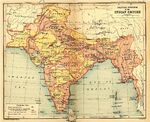
In the later part of 18th century, religious tensions and atrocities of nobles lead to the Moamoria rebellion causing tremendous casualties of lives and properties. The rebellion was suppressed but the kingdom was severely weakened by the civil war. Political rivalry between Prime Minister Purnananda Burhagohain and Badan Chandra Borphukan, the Ahom Viceroy of Western Assam, led to the invitation of Burmese by the latter,[16][17][18][19] leading to three successive invasion by Burmese on Assam. The reigning monarch Chandrakanta Singha tried to check the Burmese invaders but he was defeated after fierce resistance.[20][21][22] A reign of terror was unleashed by the Burmese on the Assamese people,[23][24][25][26] who fled to neighbouring kingdoms and British ruled Bengal.[27][28] With the Burmese having reached the East India Company’s borders, the First Anglo-Burmese War ensued in 1824. The war ended under the Treaty of Yandabo[29] in 1826, with the Company taking control of Western Assam and installing Purandar Singha as king of Upper Assam in 1833. The arrangement lasted till 1838 and thereafter the British gradually annexed the entire region. Initially Assam was made a part of the Bengal Presidency, then in 1906 it was a part of Eastern Bengal and Assam province, and in 1912 it was reconstituted into a Chief Commissioners' province. In 1913, a Legislative Council and in 1937 the Assam Legislative Assembly were formed in Shillong, the erstwhile capital of the region. The British tea planters imported labour from central India adding to the demographic canvas. After few initial unsuccessful attempts to free Assam during the 1850s, the Assamese since early 20th century joined and actively supported the Indian National Congress against the British.

Showing an historical incident at Kankalata Udyan, Tezpur
At the turn of the 20th century, British India consisted of eight provinces that were administered either by a Governor or a Lieutenant-Governor. The Assam Province was one amongst those major eight provinces of British India. The following table lists their areas and populations (but does not include those of the dependent Native States):[30]
During the partition of Bengal (1905–1911), a new province, Assam and East Bengal, was created as a Lieutenant-Governorship. In 1911, East Bengal was reunited with Bengal, and the new provinces in the east became: Assam, Bengal, Bihar and Orissa.[30]
Table hereafter shows the major original provinces during British India that includes the Assam Province:
| Province of British India[30] | Area (in thousands of square miles) | Population (in millions of inhabitants) | Chief Administrative Officer |
|---|---|---|---|
| Burma | 170 | 9 | Lieutenant-Governor |
| Bengal | 151 | 75 | Lieutenant-Governor |
| Madras | 142 | 38 | Governor-in-Council |
| Bombay | 123 | 19 | Governor-in-Council |
| United Provinces | 107 | 48 | Lieutenant-Governor |
| Central Provinces and Berar | 104 | 13 | Chief Commissioner |
| Punjab | 97 | 20 | Lieutenant-Governor |
| Assam | 49 | 6 | Chief Commissioner |
In 1947, Assam including the present Arunachal Pradesh, Nagaland, Mizoram and Meghalaya became a state of the Union of India (princely states, Manipur and Tripura became Group C provinces) and a district of Assam, Sylhet, chose to join Pakistan.
Post British[]

Since 1947, with increasing economic problems in the region, separatist groups began forming along ethnic lines, and demands for autonomy and sovereignty grew, resulting into fragmentation of Assam.
Since the mid-20th century, people from present Bangladesh have been migrating to Assam. In 1961, the Government of Assam passed a legislation making use of Assamese language compulsory. It had to be withdrawn later under pressure from Bengali speaking people in Cachar. In the 1980s the Brahmaputra valley saw a six-year Assam Agitation[31] triggered by the discovery of a sudden rise in registered voters on electoral rolls. It tried to force the government to identify and deport foreigners illegally migrating from neighboring Bangladesh and changing the demographics. The agitation ended after an accord between its leaders and the Union Government, which remained unimplemented, causing simmering discontent.[32]
The post 1970s experienced the growth of armed separatist groups like United Liberation Front of Asom (ULFA)[31] and National Democratic Front of Bodoland (NDFB). In November 1990, the Government of India deployed the Indian army, after which low-intensity military conflicts and political homicides have been continuing for more than a decade. In recent times, ethnicity based militant groups have also mushroomed. Regional autonomy has been ensured for Bodo-Kachari community in Bodoland Territorial Council Areas (BTC), for the Karbis in Karbi Anglong and for the people of Dima Hasao district after agitation of the communities due to sluggish rate of development and general apathy of successive state governments towards indigenous communities.
Geography and Climate[]

Geomorphic studies conclude that the Brahmaputra, the life-line of Assam is an antecedent river, older than the Himalayas. The river with steep gorges and rapids in Arunachal Pradesh entering Assam, becomes a braided river (at times 10 mi/16 km wide) and with tributaries, creates a flood plain (Brahmaputra Valley: 50–60 mi/80–100 km wide, 600 mi/1000 km long).[33] The hills of Karbi Anglong, North Cachar and those in and close to Guwahati (also Khasi-Garo Hills) now eroded and dissected are originally parts of the South Indian Plateau system.[33] In the south, the Barak originating in the Barail Range (Assam-Nagaland border) flows through the Cachar district with a 25–30 miles (40–50 km) wide valley and enters Bangladesh with the name Surma.
Assam is endowed with petroleum, natural gas, coal, limestone and other minor minerals such as magnetic quartzite, kaolin, sillimanites, clay and feldspar.[34] A small quantity of iron ore is available in western districts.[34] Discovered in 1889, all the major petroleum-gas reserves are in Upper parts. A recent USGS estimate shows 399 million barrels (63,400,000 m3) of oil, 1,178 billion cubic feet (3.34×1010 m3) of gas and 67 million barrels (10,700,000 m3) of natural gas liquids in the Assam Geologic Province.[35]
With the “Tropical Monsoon Rainforest Climate”, Assam is temperate (summer max. at 95–100 °F or 35–38 °C and winter min. at 43–46 °F or 6–8 °C) and experiences heavy rainfall and high humidity.[33][36] The climate is characterized by heavy monsoon downpours reducing summer temperatures and affecting foggy nights and mornings in winters. Thunderstorms known as Bordoicila are frequent during the afternoons. Spring (Mar–Apr) and Autumn (Sept–Oct) are usually pleasant with moderate rainfall and temperature.
Flora and Fauna[]

An Indian Rhino at Kaziranga National Park

A Golden Langur; endangered and found in the Chakrashila Wildlife Sanctuary in Dhubri district and in the pea-cock island of Guwahati.
Assam is one of the richest biodiversity zones in the world and consists of tropical rainforests,[37] deciduous forests, riverine grasslands,[38] bamboo[39] orchards and numerous wetland[40] ecosystems; Many are now protected as national parks and reserved forests. The Kaziranga, home of the rare Indian Rhinoceros, and Manas are two UNESCO World Heritage Sites in Assam. The state is the last refuge for numerous other endangered species such as the Golden Langur (Presbetis geei), White-winged Wood Duck or Deohanh (Cairina scutulata), Bengal Florican, Black-breasted Parrotbill, Pygmy Hog, Greater Adjutant and so on. Some other endangered species with significant population in Assam are the tiger, elephant, Hoolock gibbon, Jerdon's Babbler and so on to name a few. For the State Bird, the White-winged Wood Duck, Assam is a globally important area.[41] Assam is also known for orchids.[42] The state has the largest population of the Wild Water Buffalo in the world.[43] The state also has the highest diversity of birds in India with around 820 species.[44] With subspecies the number is as high as 946.[45] The mammal diversity in Assam is also high with around 190 species[46]
The region is prone to natural disasters with annual floods and frequent mild earthquakes. Strong earthquakes are rare; three of which were recorded in 1869, 1897 (8.1 on the Richter scale); and in 1950 (8.6).
Government and Politics[]

Assam is divided into 27 administrative districts.[47] These districts are further sub-divided into 49 “Sub-divisions” or Mohkuma.[47] Every district is administered from a district head quarter with the office of the Deputy Commissoner, District Magistrate, Office of the District Panchayat and usually with a district court.
The districts are delineated on the basis of the features such as the rivers, hills, forests, etc. and majority of the newly constituted districts are sub-divisions of the earlier districts.
The local governance system is organised under the jila-parishad (District Panchayat) for a district, panchayat for group of or individual rural areas and under the urban local bodies for the towns and cities. Presently there are 2489 village panchayats covering 26247 villages in Assam.[48] The 'town-committee' or nagar-somiti for small towns, 'municipal board' or pouro-sobha for medium towns and municipal corporation or pouro-nigom for the cities consist of the urban local bodies. Assam has two big cities. Largest City is Guwahati and other major cities are Dibrugarh, Jorhat, Silchar and Nagaon. Smaller cities are Tezpur, Tinsukia, Sivasagar, Dhubri etc. For the revenue purposes, the districts are divided into revenue circles and mouzas; for the development projects, the districts are divided into 219 'development-blocks' and for law and order these are divided into 206 police stations or thana.[48]
Tea history[]


After discovery of Camellia sinensis (1834) in Assam followed by its tests in 1836–37 in London, the British allowed companies to rent land since 1839. Thereafter tea plantations mushroomed in Upper Assam, where the soil and the climate were most suitable. Problems with the imported laborers from China and hostilities of native Assamese resulted into migration of forced laborers from central-eastern parts of India. After initial trial and error with planting the Chinese and the Assamese-Chinese hybrid varieties, the planters later accepted the local Camellia assamica as the most suitable one for Assam. By 1850s, the industry started seeing some profits. Industry saw initial growth, when in 1861, investors were allowed to own land in Assam and it saw substantial progress with invention of new technologies and machinery for preparing processed tea during 1870s. The cost of Assam tea was lowered down many folds and became more competitive than its Chinese variant.
Despite the commercial success, tea laborers continued to be exploited, working and living under poor conditions. Fearful of greater government interference, the tea growers formed the Indian Tea Association in 1888 to lobby to retain the status quo. The organization was very successful in this, and even after India’s independence, conditions of the laborers have improved very little.[49]
Economy[]


A paddy field of Assam

Macro-economy[]
The economy of Assam today represents a unique juxtaposition of backwardness amidst plenty.[52] Despite its rich natural resources, and supplying of up to 25% of India's petroleum needs, Assam’s growth rate income has not kept pace with that of India; the difference has increased rapidly since the 1970s.[53] The Indian economy grew at 6% per annum over the period of 1981 to 2000, the growth rate of Assam was only 3.3%.[54] In the Sixth Plan period, Assam experienced a negative growth rate of 3.78% when India's was positive at 6%.[53] In the post-liberalised era (after 1991), the difference widened further.
According to recent analysis, Assam’s economy is showing signs of improvement. In 2001–02, the economy grew (at 1993–94 constant prices) at 4.5%, to fall to 3.4% in the next financial year.[55] During 2003–04 and 2004–05, the economy grew (at 1993–94 constant prices) more satisfactorily at 5.5% and 5.3% respectively.[55] The advanced estimates placed the growth rate for 2005–06 at above 6%.[51] Assam's GDP in 2004 is estimated at $13 billion in current prices. Sectoral analysis again exhibits a dismal picture. The average annual growth rate of agriculture, which was only 2.6% per annum over 1980s has unfortunately fallen to 1.6% in the 1990s.[56] Manufacturing sector has shown some improvement in the 1990s with a growth rate of 3.4% per annum than 2.4% in the 1980s.[56] Since past five decades, the tertiary sector has registered the highest growth rates than the other sectors, which even has slowed down in the 1990s than in 1980s.[56]
Agriculture[]
In Assam among all the productive sectors, agriculture makes the highest contribution to its domestic sectors, accounting for more than a third of Assam’s income and employs 69% of workforce.[57] Assam's biggest contribution to the world is tea. It produces some of the finest and most expensive teas and has its own variety Camellia assamica. Assam also accounts for a fair share of India’s production of rice, rapeseed, mustard seed, jute, potato, sweet potato, banana, papaya, areca nut, sugarcane and turmeric. It is also a home of large varieties of citrus fruits, leaf vegetables, vegetables, useful grasses, herbs, spices, etc. Assam’s agriculture is yet to experience modernisation in a real sense. With implications for food security, per capita food grain production has declined in the past five decades.[58] Productivity has increased marginally, but is still low compared to highly productive regions. For instance, the yield of rice (staple food of Assam) was just 1531 kg per hectare against India’s 1927 kg per hectare in 2000–01[58] (which itself is much lower than Egypt’s 9283, US’s 7279, South Korea’s 6838, Japan’s 6635 and China’s 6131 kg per hectare in 2001[59]). On the other hand, after having strong domestic demand, and with 1.5 million hectares of inland water bodies, numerous rivers and 165 varieties of fishes,[60] fishing is still in its traditional form and production is not self-sufficient.[61]
The Assam Agriculture University is located at Jorhat, Assam. It is the only agricultural university for the Seven Sisters.
Industry[]
Apart from tea and petroleum refineries, Assam has few industries of significance. Industrial development is inhibited by its physical and political isolation from neighbouring countries such as Burma, China and Bangladesh and from other growing Southeast Asian economies; ultimately leading to neglect by the federal government in regards to development – a key motivation for separatist groups.[62] The region is landlocked, situated in the eastern periphery of India and is linked to the mainland by a flood and cyclone prone narrow corridor, known as the Siliguri Corridor or Chicken's Neck, with weak transport infrastructure that have remained undeveloped since independence. The international airport in Guwahati is yet to find providing direct international Dibrugarh is the major industrial district of Assam. Most of the big industries are situated in Dibrugarh. Dibrugarh is the Second Richest Revenue district of the nation, first district is the Mumbai District of Maharastra. The Brahmaputra suitable for navigation does not possess sufficient infrastructure for international trade and success of such a navigable trade route will be dependent on proper channel maintenance and diplomatic and trade relationships with Bangladesh.
Processed Assam tea
Assam is a major producer of crude oil and it accounts for about 15% of India's crude output,[63] exploited by the Assam Oil Company Ltd.,[64] and natural gas in India and is the second place in the world (after Titusville in the United States) where petroleum was discovered. Asia’s first successful mechanically drilled oil well was drilled in Makum (Assam) way back in 1867. Most of the oilfields are located in the Upper Assam region. Assam has four oil refineries located in Guwahati, Digboi, Golaghat (Numaligarh) and Bongaigaon with a total capacity of 7 million metric tonnes (7.7 million short tons) per annum. It is worth mentioning here that Asia's first refinery was set up at Digboi and discoverer of Digboi oilfield was the Assam Railways & Trading Company Limited (AR&T Co. Ltd.), a registered company of London in 1881.[65] Despite its richness in natural resources, the benefits have yet to improve the lives of the people of Assam. One of the reasons citated for this is various insurgencies that plagued the region as well as deficits in infrastructure.
Although having a poor overall industrial performance, several other industries have nevertheless been started, including a chemical fertiliser plant at Namrup, petrochemical industries at Namrup and Bongaigaon, paper mills at Jagiroad, Panchgram and Jogighopa, sugar mills at Barua Bamun Gaon, Chargola, Kampur, cement plant at Bokajan & Badarpur, cosmetics plant of Hindustan Unilever(HUL) at Doom Dooma, etc. Moreover, there are other industries such as jute mill, textile and yarn mills, silk mill, etc. Unfortunately many of these industries are facing loss and closure due to lack of infrastructure and improper management practices.[66]
Tourism[]
Assam is the central state in the North-East Region of India and serves as the gateway to the rest of the Seven Sister States. For the purposes of tourism there are wildlife preserves like the Kaziranga National Park, Manas National Park, Pobitora Wildlife Sanctuary, Dibru-Saikhowa National Park (Dibrugarh- Tinsukia), among others. Jokai Botanical Garden( Dibrugarh) the only Natural Botanical Garden in entire North- East India. Cultural and historical destinations also provide opportunities for tourists. Apart from wildlife preserves there are many historical places in the state like Rang Ghar, Talatal Ghar of Sivasagar, Kareng Ghar of Garhgaon, Agnigarh of Tezpur, Madan Kamdev archeological site of Kamrup etc. While visiting Madan Kamdev Tourist can also visit in Famous ancient temple Gopeswar Mandir situated in Village Deuduar. Cultural places are mainly great temple of Kamakhya, pilgrimage place Hajo, the great Vaishnava Sattras of Majuli and Barpeta and many more.
Demographics[]

| Population Growth | |||
|---|---|---|---|
| Census | Pop. | %± | |
| 1951 | 8,029,000 | ||
| 1961 | 10,837,000 | 35.0% | |
| 1971 | 14,625,000 | 35.0% | |
| 1981 | 18,041,000 | 23.4% | |
| 1991 | 22,414,000 | 24.2% | |
| 2001 | 26,656,000 | 18.9% | |
| Source:Census of India[67] The 1981 Census could not be held in Assam. Total population for 1981 has been worked out by Interpolation. | |||
As per 2011 census, total population of Assam was 31,169,272. The total population of the state has increased from 26,638,407 to 31,169,272 in the last ten years with a growth rate of 16.93%.[68]
Of the 27 districts of Assam, eight districts registered rise in the decadal population growth rate. Interestingly, religious minority-dominated districts like Dhubri, Goalpara, Barpeta, Morigaon, Nagaon, Hailakandi etc. recorded growth rates ranging from 20 per cent to 24 per cent during the last decade. On the other hand, eastern Assam districts like Sivasagar, Jorhat etc. registered around 9 per cent population growth, and for the record, these districts do not share any international border.[69]
Total population of Assam was 26.66 million with 4.91 million households in 2001.[70] Higher population concentration was recorded in the districts of Kamrup, Nagaon, Sonitpur, Barpeta, Dhubri, Darang and Cachar. Assam's population was estimated at 28.67 million in 2006 and at 30.57 million in 2011, 34.18 million by 2021 and 35.60 million by 2026.[71]
In 2011, literacy rate in the state was 73.18%. Male literacy rate was 78.81% and female literacy rate was 67.27% [68] In 2001, the census had recorded literacy in Assam at 63.3% with male literacy at 71.3% and female at 54.6%. Urbanisation rate was recorded at 12.9%.[72]
Growth of population in Assam has experienced a very high trajectory since the mid-decades of the 20th century. Population grew steadily from 3.29 million in 1901 to 6.70 million in 1941, while it has increased unprecedentedly to 14.63 million in 1971 and 22.41 million in 1991 to reach the present level.[70] The growth in the western and southern districts was extremeyl high primarily due to the rapid influx of people from East Pakistan, now Bangladesh.[32] An estimated 400,000 people have been displaced in the recent ethnic violence between indigenous Bodos and Bengali- Muslims.[73]
Assam has many ethnic groups and the People of India project has studied 115 of these. Out of which 79 (69%) identify themselves regionally, 22 (19%) locally, and 3 trans-nationally. The earliest settlers were Austroasiatic, followed by Tibeto-Burman, Indo-Aryan speakers, and Tai–Kadai speakers.[74] Forty-five languages are spoken by different communities, including three major language families: Austroasiatic (5), Sino-Tibetan (24) and Indo-European (12). Three of the spoken languages do not fall in these families. There is a high degree of bilingualism.
STs in Assam There are 23 notified Scheduled Tribes (ST) in Assam with the Bodos (40.9 per cent) making half of the total ST population (around 13 per cent) of the state. The other STs (both plains and hills) include Miri, Karbi, Rabha, Kachari, Lalung, Barman in Cachar, Borokachar, Deori, Hajai, Mech, Dimasa, Hajong, Singhphho, Khampti and Garo, Biate, Khasi, Jaintia, Synteng, Pnar, War, Bhoi, Lyngngam, and Kuki,Chakma, Hmar.
Religions[]
According to the 2001 census which is now 10 years old, there were 17,296,455 Hindus, 8,240,611 Muslims, 986,589 Christians, 22,519 Sikhs, 51,029 Buddhists, 23,957 Jains and 22,999 belonging to other religious communities.[76] The latter includes Animism (Khamti, Phake, Aiton etc. communities).
Hinduism[]

The Hindus of Assam perform several dances to practice their devotion to their Gods. One category of them is the Sattriya Dances.
Kamakhya, dedicated to Goddess Durga is the eastern-most pilgrimage of Hinduism.
Popular Hindu Gods in Assam are Durga, Shiva, Krishna and Narayana, although several tribes practice devotion to local deities as well.
Well known saints and philosophers from Assam include Srimanta Sankardeva (Assamese: শ্ৰীমন্ত শঙ্কৰ দেৱ) Gurudev Kalicharan, Madhab, Mahadeb, and very likely Kumarila Bhatta.
Brahmo Samaj: Assam is the home of Kalicharan Mech, a Bodo Hindu who stopped the British Christian missionaries, spread ahimsa and vegetarianism. He was deeply influenced by the Brahmo Samaj.[77] He later became known as "Gurudev Kalicharan Brahmachari"[78] or "Guru Brahma". His principles were established as the Brahma Dharma. Perhaps his teachings can be summarized by his given phrase, "Chandrama Surya Narayans Jyoti", meaning, "the light (jyoti) from the sun is capable from dispelling darkness and taking people to Brahma (Narayans)."[79]
From the teachings of Guru Brahma, the "Bodo-Brahmas" (the Bodos of this sect) have boycotted alcohol, heavy dowry as well as meat-eating.
This sect is written by scholars to be Vedic and Upanishadic.[80] As per Vedic rituals, the priests perform Horn Yajna, which was begun by Guru Brahma to organize the Bodos.[81]
While the Bodo Christians today are laying stress on adopting a Roman script for the Bodo community, the Bodo-Brahmas prefer the traditional Bengali-Ahomi script.
Out of the 3,308,570 Assamese tribals reported in the 2001 Census, 90.7% were Hindus and 8.8% were Christians. There were also 6,267 Muslims, 5,153 Budhists and 3,574 Animists.[82]
Islam[]
Muslims constitute the second largest religious group in Assam with 8,240,611 Muslims.[76]
In the 16th century, an Islamic saint Ajan Fakir Shah Miran and also known as Ghiyasuddin Auliya came from Baghdad to Assam to preach Islam in the area. The mosque constructed by him is known as the Pao Mecca mosque. Poa Mecca literally means one-fourth of Mecca, as the foundation of the mosque is believed to have been laid upon a handful of earth brought from Mecca. The Poa-Mecca mosque was partially destroyed by a strong earthquake that occurred in 1897 and the dargah on the 750 ft (229 m). Ghiyasuddin Auliya Ajan Fakir was buried on the hills of Gaurachol and hence the tomb on the hill is related to him, are considered sacrosanct not only by the Muslims but by people of other faiths as well.[83] Panchpeer Dargaha, in the Dhubri District is a Mazar Sharif of five Sufi Saints who accompanied Raja Ram Singh during his time of invasion to Assam. Panbari Masjid, also historically called the Rangamati Masjid, is a famous mosque near Panbari, about 25 km east from Dhubri town, and is considered to be the oldest mosque of Assam.
Christianity[]
The Bible was translated into Assamese in the year of 1819. In 1827, an attempt was made to start a Baptist church in Guwahati, but it made no permanent converts in the area. Later the American Baptist Foreign Missionary Society was able to make some headway in Guwahati. Although these earliest Christian missionary endeavors which were focused in the north-east of India, were in Modern Assam, the great success of Protestant missionaries in North-East India which they achieved in late 19th and the 20th centuries, was primarily in areas such as Nagaland, Mizoram and Meghalaya which are not part of Assam anymore.
As of 1991, only Tripura of the seven eastern states of India had a lower percentage of Christians than Assam. There were more Christians in Assam than in Mizoram even though Mizoram was the second most Christian state in India at the time.[84]
Besides the Protestants there are also Catholics. There is a Roman Catholic Archdiocese in Shillong.
According to the 2001 Census, there are a total of 986,589 Christians in Assam.[85] Out of this, 291,000 (29.5%) are tribals.[82]
Sikhism[]

The first Guru of the Sikhs, Guru Nanak Dev had visited Kamrup (Assam) in the 1505 as recorded in the his first visit in Purantan Janam Sakhi (the historical papers related to the visits and daily recorded activities of the Guru). Guru Nanak had met Srimanta Shankardeva (the founder of the Mahapuruxiya Dharma) as the Guru travelled from Dhaka to Assam. But no sangat or historical shrine dedicated to him survives as to date.
Ninth Guru of Sikhs Guru Tegh Bahadur visited Assam in 1668. This place is also famous for the Sikh Gurdwara Thara Sahib or Gurdwara Damdama Sahib which was constructed in memory atop the hillock place of meditation of the Guru in Dhubri, Kamrup. The historical site and places of interest of the Gurdwara are many times referred to as Gurdwara Sri Guru Tegh Bahadur Sahib situated in Dhubri (Assam) by the banks of the Brahmaputra .[86] The grateful Ahom King invited Guruji to the Kamakhya shrine, where he was honoured with great respect.
In the year 1820, few hundred Sikh soldiers went to Assam at the initiative of Maharaja Ranjit Singh to help Ahom rulers in a war. Their descendants are mostly concentrated in Lanka in Nagaon district of Assam.[87] Sikhs have been living in Assam for approximately two hundred years.[88]
Buddhism[]
The religion is practised by 51,029 persons in Assam. Among them are the Chakma, Mutsuddi and Boruas. The Chakmas of Assam are located mostly in Cachar and Karbi Anglong with very lesser presence in Nagaon district. The chakmas are originally from the Chittagong area of Bangladesh. Guwahati has lots of Buddhist temples, the most prominent being the Bamunimaidan Buddhist temple.
The Indigenous Tai tribes like Tai Phake, Tai Aiton, Khamyang, Turung, Singpho and Khampti are also buddhist by religion. They mainly inhabit Upper Assam and also Karbi Anglong.
There is also a small Bhutanese and Tibetan population in Assam.
Languages[]

7th–8th century specimen of Assamese (Kamrupi) literature
.
Languages of Assam in 2001[89]
Assamese and Bodo are the major indigenous and official languages while Bengali holds official status in the three districts in the Barak Valley and is the second most widely spoken language of the state (27.91%).[89]
Traditionally Assamese was the language of the commons (of mixed origin – Austroasiatic, Tibeto-Burman, Prakrit) in the ancient Kamarupa and in the medieval kingdoms of Kamatapur, Kachari, Sutiya kingdom, Borahi, Ahom and Koch. Traces of the language is found in many poems by Luipa, Sarahapa, etc. in Charyapada (c.7th–8th AD). Modern dialects Kamrupi, Goalpariya etc. are the remnants. Moreover, Assamese in its traditional form was used by the ethno-cultural groups in the region as lingua-franca, which spread during the stronger kingdoms and was required for needed economic integration. Localised forms of the language still exist in Nagaland, Arunachal Pradesh. The form used in the upper Assam was enriched by the advent of Tai-Shans in the 13th century.
Linguistically modern Assamese traces its roots to the version developed by the American Missionaries based on the local form in practice near Sibsagar (Siwoxagor) district. Assamese (Osomeeya) is a rich language due to its hybrid nature with its unique characteristics of pronunciation and softness. Assamese literature is one of the richest.
Dimasa is a one of the oldest languages spoken in North East India particularly in Assam. The word Dimasa etymologically translates to "Son of the big river " (Di- Water, ma- suffix for great, sa-sons), the river being the mighty Brahmaputra. The Dimasa word "Di" for water forms the root word for many of the major rivers of Assam and the North East India like Dikrang which means green river, Dikhow which means "fetched water", Diyung ( huge river) etc. The mighty river Brahmaputra is known as Dilao (long river) among the Dimasas even now. Many of the important towns and cities in Assam and Nagaland found their names from the Dimasa word such as Diphu, Dimapur (a capital of Dimasa Kingdom), Dispur, Hojai, Khaspur, etc. In fact, Dimasa language is one of the last languages of the North East India which still has undiluted rich vocabularies.
Bodo is an ancient language of Assam. Spatial distribution patterns of the ethno-cultural groups, cultural traits and the phenomenon of naming all the major rivers in the North East Region with Bodo-Kachari words (e.g. Dihing, Dibru, Dihong, D/Tista, Dikrai, etc.) reveal that it was the most important language in the ancient times. Bodo is presently spoken largely in the Western Assam (Bodo Territorial Council area). After years of neglect, now Bodo language is getting attention and its literature is developing. Other native languages of Tibeto-Burman origin and related to Bodo-Kachari are Deori[1], Mising, Karbi, Rabha, Tiwa, etc. Rajbongshi also known as Kamatapuri/Goalpariya is also widely spoken by the people of western Assam.
Nepali is also spoken in almost all parts of the state. There are approximately thirty lakhs of Nepali speakers spreading over the area of all the district of Assam. Assamese language being the main language, they are well versed in it. Assamese language is the main medium in educational institutions but Nepali language is also taught as a major Indian language. In Guwahati and Digboi, many Jr. basic School and Jr. high School are Nepali medium where all the teachers are Nepali. As a major Indian language, Nepali is included by Assam State Secondary Board, Assam Higher Secondary Council and Gauhati University in their HSCL, higher secondary and graduation level respectively, in some junior basic and higher secondary schools and colleges, Nepali teachers and lecturers are also appointed. In these institutions, Nepali and literature are taught.
There are also speakers of Tai languages in Assam. A total of six Tai language were spoken in Assam, although two are now extinct.[90]
- Tai Phake
- Tai Aiton
- Khamti
- Khamyang (critically endangered)
- Ahom (extinct)
- Turung (extinct)
The Tai Ahom language (brought by Sukaphaa and his followers), is no longer a spoken language today, but is receiving increased attention for research after centuries of long care and preservation by the Bailungs (traditional priests). There are also small groups of people speaking their own dialects such as Manipuri, Khasi, Garo,[Biate language(Biate)], Hmar, Kuki, Zeme Naga etc. in different parts.
Bengali is the official language in Barak Valley and the widely spoken language there is Sylheti, a dialect of Bengali. Bengali is also largely spoken in the western districts of Dhubri, Barpeta and Goalpara. On the 19th of May, 1961, 11 persons were killed by police firing in Silchar in Cachar, Barak Valley, when they were protesting the state government's decision to make Assamese the official language in all parts of the state. The day is observed as 'Bhasha Shaheed Diwas' in Barak Valley every year.
Santali or Santhali is also spoken widely by the tribal population in the tea garden districts of Assam. these people who were initially brought as tea estate labourers by the British to Assam have now made it their home state.
Bishnupriya Manipuri language is also spoken by a small minority of people in Barak Valley.
Some of the other languages spoken in Assam are Missing, Rabha and Karbi.
Culture[]
Assamese culture is traditionally a hybrid one developed due to assimilation of ethno-cultural groups in the past. Therefore, both local elements or the local elements in Sanskritised forms are distinctly found.[91] The major milestones in evolution of Assamese culture are:
- Assimilation in the Kamarupa Kingdom for almost 700 years (under the Varmans for 300 years, Salastambhas and Palas for each 200 years).[13]
- Establishment of the Ahom dynasty in the 13th century AD and assimilation for next 600 years.[13]
- Assimilation in the Koch Kingdom (15th–16th century AD) of western Assam and Kachari Kingdom (12th–18th century AD) of central and southern Assam.[13]


- Vaishnava Movement led by Srimanta Shankardeva (Sonkordeu) and its contribution and cultural changes. Vaishanav Movement, the 15th century religio-cultural movement under the leadership of great Srimanta Sankardeva (Sonkordeu) and his disciples have provided another dimension to Assamese culture. A renewed Hinduisation in local forms took place, which was initially greatly supported by the Koch and later by the Ahom Kingdoms. The resultant social institutions such as namghar and sattra (the Vaishnav Monasteries) have become part of Assamese way life. The movement contributed greatly towards language, literature and performing and fine arts. It is also noticed that many a times, Vaishnav Movement attempted to introduce alien cultural attributes and modify the way of life of common people. Brajavali a language specially created by introducing words from other Indian languages had failed as a language but left its traces on the Assamese language. Moreover, new alien rules were also introduced changing people's food habits and other aspects of cultural life. This had a greater impact on alienation of many local ethno-cultural and political groups in the later periods.
Historically, it is not difficult to understand that on one hand, during the strong politico-economic systems under stronger dynasties, greater cultural assimilation's created common attributes of Assamese culture, while on the other during smaller politico-economic systems or during political disintegration, more localised attributes were created with spatial differentiation. Time-factor for such integrations and differentiations has also played extremely important role along with the position of individual events in the entire series of sequential events.
With rich traditions, the modern culture is greatly influenced by events in the British and the Post-British Era. The language was standardised by the American Baptist Missionaries such as Nathan Brown, Dr. Miles Bronson and local pundits such as Hemchandra Barua with the form available in the Sibsagar (Sivasagar) District (the ex-nerve centre of the Ahom Kingdom). A renewed Sanskritisation was increasingly adopted for developing Assamese language and grammar. A new wave of Western and northern Indian influence was apparent in the performing arts and literature.
Increasing efforts of standardisation in the 20th century alienated the localised forms present in different areas and with the less-assimilated ethno-cultural groups (many source-cultures). However, Assamese culture in its hybrid form and nature is one of the richest, still developing and in true sense is a 'cultural system' with sub-systems. It is interesting that many source-cultures of Assamese cultural-system are still surviving either as sub-systems or as sister entities, for e.g. Bodo or Karbi or Mishing. It is important to keep the broader system closer to its roots and at the same time to focus on development of the sub-systems.
Some of the common and unique cultural traits in the region are peoples' respect towards areca-nut and betel leaves, symbolic (Gamosa, Arnai, etc.), traditional silk garments (e.g. Mekhela chador, traditional dress of Assamese women) and towards forefathers and elderly. Moreover, great hospitality and Bamboo culture are common.
Symbolism[]

Symbolism is an ancient cultural practice in Assam and is still a very important part of Assamese way of life. Various elements are being used to represent beliefs, feelings, pride, identity, etc. Tamulpan, Xorai and Gamosa are three important symbolic elements in Assamese culture. Tamulpan (the areca nut and betel leaves) or guapan (gua from kwa) are considered along with the Gamosa (a typical woven cotton or silk cloth with embroidery) as the offers of devotion, respect and friendship. The Tamulpan-tradition is an ancient one and is being followed since time-immemorial with roots in the aboriginal Austro-Asiatic culture. Xorai is a traditionally manufactured bell-metal article of great respect and is used as a container-medium while performing respectful offers. Moreover, symbolically many ethno-cultural groups use specific clothes to portray respect and pride.
There were many other symbolic elements and designs, but are now only found in literature, art, sculpture, architecture, etc. or in use today for only religious purposes. The typical designs of assamese-lion, dragon, flying-lion, etc. were used for symbolising various purposes and occasions. The archaeological sites such as the Madan Kamdev (c. 9th–10th AD) exhibits mass-scale use of lions, dragon-lions and many other figures of demons to show case power and prosperity. The Vaishnava monasteries and many other architectural sites of late medieval period also showcase use of lions and dragons for symbolic effects.
Festivals[]

Bihu dancers and drummer with a dhul.
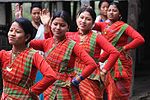
Mising girls dancing during Ali Ai Ligang (Spring Festival)
There are diversified important traditional festivals in Assam. Bihu is the most important and common and celebrated all over Assam. It is the Assamese new year celebrated in April of the Gregorian calendar. Durga Puja is another festival celebrated with great enthusiasm. Muslims celebrate two Eids (Eid ul-Fitr and Eid al-Adha) with much eagerness all over Assam.
Bihu is a series of three prominent festivals. Primarily a non-religious festival celebrated to mark the seasons and the significant points of a cultivator's life over a yearly cycle. Three Bihus, rongali or bohag, celebrated with the coming of spring and the beginning of the sowing season; kongali or kati, the barren bihu when the fields are lush but the barns are empty; and the bhogali or magh, the thanksgiving when the crops have been harvested and the barns are full. Bihu songs and Bihu dance are associated to rongali bihu. The day before the each bihu is known as 'uruka'. The first day of 'rongali bihu' is called 'Goru bihu' (the bihu of the cows), when the cows are taken to the nearby rivers or ponds to be bathed with special care. In recent times the form and nature of celebration has changed with the growth of urban centres.
Bwisagu is one of the popular seasonal festival of the Bodos. Bwisagu start of the new year or age. Baisagu is a Boro word which originated from the word "Baisa" which means year or age, ang "Agu" that means starting or start.
Bushu Dima or simply Bushu is a major harvest festival of the Dimasa people. This festival is celebrated during the end of January. Officially 27 January has been declared as the day of Bushu Dima festival. The Dimasa people celebrate their festival by playing musical instruments- khram (a type of drum), muri ( a kind of huge long flute). The people dances to the different tunes called "murithai" and each dance has got its name, the prominent being the "Baidima" There are three types of Bushu celebrated among the Dimasas Jidap, Surem and Hangsou.
Moreover, there are other important traditional festivals being celebrated every year on different occasions at different places. Many of these are celebrated by different ethno-cultural groups (sub and sister cultures). Some of these are:
|
|
|
|
Other few yearly celebrations are Brahmaputra Beach Festival, Guwahati, Kaziranga Elephant Festival, Kaziranga and Dehing Patkai Festival, Lekhapani. Few yearly Mela's like Jonbeel Mela, began in 15th Century by the Ahom Kings, Ambubachi Mela, Guwahati, Karbi Youth Festival, Diphu and International Jatinga Festival, Jatinga can not be forgotten.
Music, Dance and Drama[]
Assam has rich tradition of performing arts. Ankia Naat (Onkeeya Naat) is a traditional Vaishnav dance-drama (Bhaona) form popular since 15th century AD It makes use of large masks of gods, goddesses, demons and animals and in between the plays a Sutradhar (Xutrodhar) keeps on telling the story.
The Bihu dance and Hucory performed during the Bohag Bihu, Kushan nritra of Rajbongshi's, Bagurumba and Bordoicikhla dance of Bodos, Mishing Bihu, Banjar Kekan performed during Chomangkan by Karbis are some of the major folk dances. Sattriya (Sotriya) dance related to Vaishnav tradition is a classical form of dance. Moreover, there are several other age-old dance-forms such as Barpeta’s Bhortal Nritya, Deodhoni Nritya, Ojapali, Beula Dance, Ka Shad Inglong Kardom, Nimso Kerung, etc. The tradition of modern moving theatres is typical of Assam with immense popularity of many large theatre groups such as Kohinoor, Srimanta Sankardev, Abahan, Bhagyadevi, Hengul, Rajmahal, Itihas etc.
At the same time musical tradition is also rich. Folk songs and music related to Bihu and other festivals dates back to time-immemorial. Borgeet, the popular Vaishnav songs are written and composed in 15th century. Assam has large numbers of traditional musical instruments including several types of drums, string instruments, flutes, cymbals, pipes, etc.
The indigenous folk music has substantially influenced the growth of a modern idiom, that finds expression in the music of such artists like Jyoti Prasad Agarwala, Bishnuprasad Rabha, Parvati Prasad Baruwa, Bhupen Hazarika, Pratima Barua Pandey, Anima Choudhury, Luit Konwar Rudra Baruah, Jayanta Hazarika, Khagen Mahanta, Deepali Borthakur, Ganashilpi Dilip Sarma, Sudakshina Sarma among many others. Among the new generation, Zubeen Garg, Jitul Sonowal, Angaraag Mahanta and Joi Barua have a great fan following. There is an award given in the honour of Bishnuprasad Rabha for achievements in the cultural/music world of Assam by the State Government
Cuisine[]

Assamese Thali
Typically, an Assamese plate would contain bhaat (rice) with dal (lentils), masor jool (fish curry), with mangso (meat curry) or xaak and bhaji (herbs and vegetables).
Rice one of the main dish in Assam, and variety of different rices are grown and eaten in different ways, roasted, grounded, boiled or just soaked.
Fish curries made of rou, illish, or chitol are the most favorite. If not a curry, simply fried fish. Birds like ducks and pigeon are also used in dishes. Pork and Mutton dishes are mainly popular among the younger generation.
Another favourite combination can be looci (puffed bread), a curry which can be vegetarian or non-vegetarian, and asar (pickle).
Two main characteristic of a traditional meal in Assam are Khar and Tenga. A class of dishes named after the main ingredient Khar and a sour dish is a Tenga.
Khorisa (bamboo shoot) are used at times for flavours in curries. They also can be preserved and made into pickles. Koldil (Banana Flower) and Squash are also cooked into delicious sabji's.
The food is usually served in bell metal utensils.
Literature[]
Noted writers:
|
|
|
Fine arts[]

Citra Bhagavata illustration

The archaic Mauryan Stupas discovered in and around Goalpara district are the earliest examples (c. 300 BC to c. 100 AD) of ancient art and architectural works. The remains discovered in Daparvatiya (Doporboteeya) archaeological site with a beautiful doorframe in Tezpur are identified as the best examples of art works in ancient Assam with influence of Sarnath School of Art of the late Gupta period. Many other sites also exhibit development of local art forms with local motifs and sometimes with similarities with those in the Southeast Asia. There are currently more than forty discovered ancient archaeological sites across Assam with numerous sculptural and architectural remains. Moreover, there are examples of several Late-Middle Age art and architectural works including hundreds of sculptures and motifs along with many remaining temples, palaces and other buildings. The motifs available on the walls of the buildings such as Rang Ghar, Joydoul, etc. are remarkable examples of art works.
Painting is an ancient tradition of Assam. Xuanzang (7th century AD) mentions that among the Kamarupa king Bhaskaravarma's gifts to Harshavardhana there were paintings and painted objects, some of which were on Assamese silk. Many of the manuscripts such as Hastividyarnava (A Treatise on Elephants), the Chitra Bhagawata and in the Gita Govinda from the Middle Ages bear excellent examples of traditional paintings. The medieval Assamese literature also refers to chitrakars and patuas.
There are several renowned contemporary artists in Assam. The Guwahati Art College is a government institution for tertiary education. Moreover, there are several art-societies and non-government initiatives across the state.
Traditional crafts[]
Assam has a rich tradition of crafts; presently, Cane and bamboo craft, bell metal and brass craft, silk and cotton weaving, toy and mask making, pottery and terracotta work, wood craft, jewellery making, musical instruments making, etc. remained as major traditions.[92] Historically, Assam also excelled in making boats, traditional guns and gunpowder, ivory crafts, colours and paints, articles of lac, agarwood products, traditional building materials, utilities from iron, etc.
Cane and bamboo craft provide the most commonly used utilities in daily life, ranging from household utilities, weaving accessories, fishing accessories, furniture, musical instruments, construction materials, etc. Utilities and symbolic articles such as Sorai and Bota made from bell metal and brass are found in every Assamese household.[93][94] Hajo and Sarthebari (Sorthebaary) are the most important centres of traditional bell-metal and brass crafts. Assam is the home of several types of silks, the most prestigious are: Muga – the natural golden silk, Pat – a creamy-bright-silver coloured silk and Eri – a variety used for manufacturing warm clothes for winter. Apart from Sualkuchi (Xualkuchi), the centre for the traditional silk industry, in almost every parts of the Brahmaputra Valley, rural households produce silk and silk garments with excellent embroidery designs. Moreover, various ethno-cultural groups in Assam make different types of cotton garments with unique embroidery designs and wonderful colour combinations.
Moreover, Assam possesses unique crafts of toy and mask making mostly concentrated in the Vaishnav Monasteries, pottery and terracotta work in Western Assam districts and wood craft, iron craft, jewellery, etc. in many places across the region.
Sports[]
Assam is the home of many ancient sports which have been played since Ahom era, include Koni-juj, Kori khel, Moh juj, Bulbuli sorair juj, Kaar khel etc. Assam produced many eminent sportsmen who have brought laurels to India like Arjun Bhugeswar Baruah, Olympians Dipankar Bhattacharjee, Jayanta Talukdar and Shiva Thapa. Cricket and football are the most popular sport of Assam.Guwahati has many sports stadiums include Nehru Stadium, Indira Gandhi Athletic Stadium, Rajiv Gandhi Indoor Stadium, Deshbhakta Tarun Ram Phukan Indoor Stadium, Chachal Tennis Complex, Dr. Zakir Hussain Aquatic Complex, Maulana Md. Tayabullah Hockey Stadium, Tepesia Sports Complex, SAI Complex Maligaon NF Railway Stadium etc. Bordoloi Trophy, a very old and prestigious annual football tournament held at Nehru Stadium, Guwahati.
Media[]
Print media include Assamese dailies Dainik Janambhumi, Amar Asom, Dainik Agradoot, Asomiya Pratidin, Asomiya Khobor, Janasadharan, Niyamiya Barta and Gana Adhikar. Asom Bani and Sadin are notable Assamese weekly newspaers. English dailies of Assam include The Assam Tribune, The Sentinel, The Telegraph and Seven Sisters Post. There are around five All India Radio stations in Assam. Assam has three Doordarshan kendras at Guwahati, Dibrugarh and Silchar. Guwahati has headquarters of many electronic medias like NE TV, News Live, DY 365, Prime News, News Time Assam, Frontier TV, News Network and Prag News.
Education[]
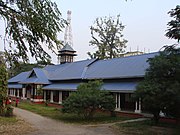
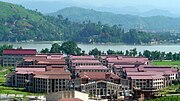

Assam boasts of the most wide-ranging networks of higher educational institutions in the whole of North-Eastern region of India. Assam has developed into a top educational destination at the state as well as at the national level. To enhance the status of Assam education, the state government has introduced many innovative education polices. Its capital city, Guwahati, is a key destination for higher education for students of the whole of north-eastern region. A special mentioning is deserved by Cotton College, Guwahati which holds a heritage that goes back a century (Estd. 1901). One of India's best boarding schools The Assam Valley School is located at Balipara in the Sonitpur(Tezpur) District of Assam. It is a co-educational ICSE residential school. Assam has several institutions for tertiary education and research. Assam's other major cities like Silchar and Dibrugarh are also major educational hubs with universities, medical colleges and engineering colleges established there.
The major institutions are:
Universities[]
- Gauhati University, Guwahati
- National Law University And Judicial Academy,Assam
- Dibrugarh University, Dibrugarh
- Tezpur Central University, Tezpur
- K.K.Handique State Open University, Guwahati, Dibrugarh
- Assam Central University, Silchar
- Assam Agricultural University, Jorhat
- Bodoland University,[95] Kokrajhar
- Don Bosco University,[96] (private)
- Assam Down Town University,[97] (private)
- Kaziranga University,[98] Jorhat (private)
Medical Colleges[]
- Assam Medical College, Dibrugarh
- Gauhati Medical College and Hospital, Guwahati
- Silchar Medical College and Hospital, Silchar
- Jorhat Medical College,[99] Jorhat
- Fakhruddin Ali Ahmed Medical College, Barpeta
- Dr. J. K. Saikia Homeopathic Medical College, Jorhat
- Assam Government Ayurvedic College, Guwahati
- Susruta School of Medical and Paramedical Sciences,
Government Technology and Engineering College[]
- Indian Institute of Technology, Guwahati
- National Institute of Technology, Silchar
- Central Institute of Technology, Kokrajhar
- Assam Engineering College, Guwahati
- Jorhat Engineering College, Jorhat
- Bineswar Brahma Engineering College,Kokrajhar
- Jorhat Institute of Science and Techhnology, Jorhat
- Dibrugarh University Institute of Engineering and Technology, Dibrugarh University, Dibrugarh
- Triguna Sen School of Technology, Assam University, Silchar
- School of Engineering, Tezpur University, Tezpur
Private Technology and Engineering College[]
- Girijananda Chowdhury Institute of Management and Technology, Guwahati
- Don Bosco College of Engineering and Technology, Guwahati
- Royal School of Engineering and Technology, Guwahati
- NETES Institute of Technology and Science Mirza
- Down Town College of Engineering, Guwahati
- KU School of Engineering, Technology and Managment
Law Academy[]
- Jorhat Law College, Jorhat.
- Tinsukia Law College, Tinsukia
- National Educational Foundation (NEF) Law College, Guwahati
- J.B Law College, Guwahati
- Department Of Law,Guwahati University, Guwahati
- National Law University and Judicial Academy, Assam, Guwahati
- Law and judicial studies Dibrugarh University, Dibrugarh.
- Deshabandhu Chittaranjan School of Legal Studies, Assam Central University, Silchar
The National Law University and Judicial Academy, Assam is located in the capital city of Assam, Guwahati, with its permanent campus under construction at Agiyathuri, on the Northern bank of the Brahmaputra. Nestled in the midst of greenery with a campus area covering 21 acres (8 ha), the Academy will offer the right atmosphere for educational pursuits and excellence.
See also[]
- Outline of India
- Index of India-related articles
- Bibliography of India
 India
India at Wikipedia books
at Wikipedia books
- List of people from Assam
- List of Assam state symbols
- List of Cities and Towns in Assam
- 1897 Assam earthquake
- 1950 Assam earthquake
- Asom Sahitya Sabha
- Assam agitation
- Assam Rifles
- Assam Accord
- Assamese Associations
- Assamese Brahmins
- Assamese cinema
- Assamese cuisine
- Baruah
- Biodiversity of Assam
- Culture of Assam
- Cultural Development of Kamarupa
- Districts of Assam
- Early Period of Kamarupa
- Etymology of Assam
- Fine Arts of Assam
- Greater Assam
- History of Assam
- Kalitas of Assam
- Kamrupi Literature
- Kamrupi Brahmins
- Kamarupa Anusandhan Samiti
- Kamrupi Lokgeet
- Kamarupa of Bhaskar Varman
- Kamarupa - Late to end period
- Mishing language
- Music of Assam
- People of Assam
- Physical Geography of Assam
- Political parties in Assam
- State Anthem of Assam
- Tourism in Assam
- Traditional crafts of Assam
- Textiles and dresses of Assam
- Varman Dynasty
Notes[]
- ^ "Assam Population Sex Ratio in Assam Literacy rate data". Census2011.co.in. http://www.census2011.co.in/census/state/assam.html. Retrieved 2012-09-22.
- ^ Web.com(india) Pvt. Ltd. (2007-02-18). "Assam at a glance". Assam.gov.in. http://assam.gov.in/glance.asp. Retrieved 2012-09-22.
- ^ "Commissioner Linguistic Minorities". Archived from the original on 8 October 2007. http://web.archive.org/web/20071008113359/http://nclm.nic.in/shared/linkimages/35.htm. Retrieved 1 December 2010.
- ^ Dixit, K. M. (August 2002). "Chicken's Neck (Editorial)" (– Scholar search). Himal South Asian. http://www.himalmag.com/2002/august/lastpage.htm.
- ^ Sushanta Talukdar (April 20, 2012). "Assam has lead role in Look East effort: PM". The Hindu. http://www.thehindu.com/news/national/article3336069.ece. Retrieved 4 December 2012.
- ^ World Heritage Centre, UNESCO. "World Heritage List". http://whc.unesco.org/pg.cfm?cid=31.
- ^ "Prior to the thirteenth century the present region was called Kāmarūpa or, alternatively, Prāgjyotiṣapur", Lahiri, Nayanjot., Pre-Ahom Assam (Delhi 1991) p14
- ^ "The word 'Assamese' is an English one based on the anglicised form 'Assam' from the native word "Asam", which in its turn is connected with the Shans who invaded the Brahmaputra Valley in the 13th century." Kakati, Banikanta, Aspects of Early Assamese Literature (Gauhati University Press, 1953) p1; "Assam is the English form of 'Asama' (ie peerless) which is apparently a Sanskritised form of the tribal name Ahom", D C Sircar, Pragjyotisha-Kamarupa in The Comprehensive History of Assam Vol I (Guwahati, 1991) p59 cf1; Satyendra Nath Sharma, Assamese Literature (Wiesbaden : Harrassowitz, 1976) p1; "The term 'Assam' is, relatively speaking, of recent origin and traces back to the tradition of the Ahoms who entered the Brahmaputra valley in the thirteenth century", Nayanjot Lahir, Pre-Ahom Assam (Delhi 1991, based on PhD Thesis) p14; "These references show that the term 'Axom or Asom' was earlier used to mean the Shan community...Subsequently the term came to be used to mean also the territory they ruled", M Taher, Geography of Assam (Delhi, 2001) pp2-3
- ^ "...but most probably Asama meaning peerless or unequalled is a latter day Sanskritisation of some earlier form like Āchām, Banikanta Kakati, Early Aspects of Assamese Literature (Gauhati, 1953) p2
- ^ Satyendra Nath Sharma, Assamese Literature (Wiesbaden : Harrassowitz, 1976) p1
- ^ "In Tai the root cham means "to be undefeated". With the privative Assamese affix ā the whole formation Āchām would mean undefeated.", Banikanta Kakati, Aspects of Early Assamese Literature (Gauhati University Press, 1953) p2
- ^ "The Ahom domain of Upper Assam came to be known to the Dimasa and other Bodo people as Ha-Sam (the land of the Shams or Shans) in their language.", Amalendu Guha, The Ahom Political System: An Enquiry into the State Formation Process in Medieval Assam (1228-1714) in Social Scientist Vol. 11, No. 12, (1983) p24
- ^ a b c d e Barpujari, H. K. (ed.) (1990), The Comprehensive History of Assam, 1st edition, Guwahati, India: Assam Publication Board
- ^ (Sircar 1990:63–68)
- ^ Banikanta Kakati, Assamese:Its formation and development The Shans built their kingdom and consolidated their power in Eastern Assam with the modern town of Sibsagara as their capital and brought the whole tract down to the border of the modern district of Kamrup permanently under their sway. It was towards the close of their reign that modern Kamrup came within the compass of the Shan rule.
- ^ Gait E.A. A History of Assam 1926 Calcutta and Shimla Thacker & Co page 225
- ^ Bhuyan Dr. S.K. Tunkhungia Buranji or A History of Assam (1681-1826) 1968 page 199
- ^ Barbaruah Hiteswar Ahomar-Din or A History of Assam under the Ahoms 1981 page 299
- ^ Barua Gunaviram Assam Buranji or A History of Assam 2008 page 108
- ^ Gait E.A. A History of Assam 1926 Calcutta and Shimla Thacker & Co page 230
- ^ Bhuyan Dr. S.K. Tunkhungia Buranji or A History of Assam (1681-1826) 1968 page 206
- ^ Barbaruah Hiteswar Ahomar-Din or A History of Assam under the Ahoms 1981 page 320
- ^ Gait E.A. A History of Assam 1926 Calcutta and Shimla Thacker & Co page 231
- ^ Bhuyan Dr. S.K. Tunkhungia Buranji or A History of Assam (1681-1826) 1968 page 207
- ^ Barbaruah Hiteswar Ahomar-Din or A History of Assam under the Ahoms 1981 page 318
- ^ Barua Gunaviram Assam Buranji or A History of Assam 2008 page 116-117
- ^ Gait E.A. A History of Assam 1926 Calcutta and Shimla Thacker & Co page 232
- ^ Barua Gunaviram Assam Buranji or A History of Assam 2008 page117
- ^ Aitchison, C. U. ed (1931), The Treaty of Yandaboo, (A Collection of Treaties, Engagements and Sanads: Relating to India and Neighbouring Countries. Vol. XII.), Calcutta: Projectsouthasia.sdstate.edu, pp. 230–233, http://projectsouthasia.sdstate.edu/Docs/history/primarydocs/Treaties/Burma/002.htm
- ^ a b c Imperial Gazetteer of India vol. IV 1907, p. 46
- ^ a b Hazarika, Sanjoy (2003), Strangers of the Mist, Penguin Books Australia Ltd., ISBN 0-14-024052-7
- ^ a b Governor of Assam (8 November 1998). "Report on Illegal Migration into Assam". Archived from the original on 9 June 2007. http://www.satp.org/satporgtp/countries/india/states/assam/documents/papers/illegal_migration_in_assam.htm. Retrieved 26 May 2007.
- ^ a b c Singh, R. L. (1993), India, A Regional Geography, Varanasi, India: National Geographical Society of India
- ^ a b NEDFi & NIC-Assam. "North East India Databank". http://nerdatabank.nic.in/as_minerals.htm.
- ^ Wandrey 2004, p. 17
- ^ Purdue University. "The Köppen Classification of Climates". Archived from the original on 5 June 2007. http://www.hort.purdue.edu/newcrop/tropical/lecture_04/lec_04.html. Retrieved 25 May 2007.
- ^ Borthakur, Ahir Bhairab (15 January 2002), "Call of the wild", Down to Earth, http://www.downtoearth.org.in/full6.asp?foldername=20020115&filename=gra&sec_id=11&sid=1.
- ^ Birdlife International, UK. "Indo-Gangetic Grasslands". http://www.birdlife.org/action/science/species/asia_strategy/pdf_downloads/grasslandsGO2.pdf.
- ^ National Mission on Bamboo Applications 2004
- ^ Sharma, Pradip (April–June 2003), "An Overview on Wetlands in Assam", ENVIS Assam, Assam Science Technology and Environment Council 2: 7, http://www.envisassam.org/VOL2_2.pdf.
- ^ Choudhury, A.U.(1996) Survey of the white-winged wood duck and the Bengal florican in Tinsukia district & adjacent areas of Assam and Arunachal Pradesh. The Rhino Foundation for Nature in North East India, Guwahati, India. 82pp+
- ^ ENVIS Assam (April–June 2003), "Endemic Orchids of Assam", ENVIS Assam, Assam Science Technology and Environment Council 2: 8, http://www.envisassam.org/VOL2_2.pdf.
- ^ Choudhury, A.U. (2010)The vanishing herds : the wild water buffalo. Gibbon Books, Rhino Foundation, CEPF & COA, Taiwan, Guwahati, India
- ^ Choudhury, A.U. (2000)The birds of Assam. Gibbon Books & WWF-India, Guwahati, India
- ^ Choudhury, A.U. (1990). Checklist of the birds of Assam. Sofia Press & Publishers Pvt. Ltd., Guwahati, India. 72 pp+
- ^ Choudhury, A.U. (1997)The check list of the mammals of Assam. Gibbon Books & ASTEC, Guwahati, India
- ^ a b Revenue Department, Government of Assam
- ^ a b Directorate of Information and Public Relations, Government of Assam. "Area of the National Parks and Wildlife Sanctuaries in Assam, 2002". http://janasanyogassam.nic.in/assamataglance.htm. Retrieved 29 May 2006.
- ^ MacFarlane, Alan; MacFarlane, Iris (2003), Green Gold, The Empire of Tea, Ch. 6–11, Random House, London
- ^ Government of Assam. "Economic Survey of Assam 2001–2002 in Assam Human Development Report, 2003" (PDF). p. 25. http://planassam.org/reports/hdr_2003/HRD.htm. Retrieved 6 June 2007.
- ^ a b Government of Assam. "Economic Survey of Assam 2005–2006 in NEDFi, Assam Profile, NER Databank". http://databank.nedfi.com/index.php?module=pagemaster&PAGE_user_op=view_page&PAGE_id=4. Retrieved 6 June 2007.
- ^ National Commission for Women 2004
- ^ a b UNDP 2004, pp. 22–23
- ^ UNDP 2004, p. 22
- ^ a b Government of Assam (2006). "Economic Survey of Assam 2004–2005 in NEDFi, Assam Profile, NER Databank". http://databank.nedfi.com/index.php?module=pagemaster&PAGE_user_op=view_page&PAGE_id=4. Retrieved 6 June 2007.
- ^ a b c UNDP 2004, pp. 24–25
- ^ Government of Assam. Chapter 2, Income, Employment and Poverty "Economic Survey of Assam 2001–2002 in Assam Human Development Report, 2003" (PDF). p. 32. http://planassam.org/reports/hdr_2003/HRD.htm Chapter 2, Income, Employment and Poverty. Retrieved 6 June 2007.
- ^ a b UNDP 2004, p. 33
- ^ FAO Statistics Division, 2007, Food and Agriculture Organization of the United Nations. "Faostat" (– Scholar search). Archived from the original on 14 November 2006. http://web.archive.org/web/20061114202949/http://faostat.fao.org/site/340/DesktopDefault.aspx?PageID=340. Retrieved 5 June 2006.
- ^ Assam Small Farmers’ Agri-business Consortium. "Fish Species of Assam". Archived from the original on 14 May 2006. http://www.assamagribusiness.nic.in/2ndoct/fishspeciesofAssam.pdf. Retrieved 5 June 2006.
- ^ UNDP 2004, p. 37
- ^ "MAR | Data | Assessment for Assamese in India". Cidcm.umd.edu. 31 December 2006. http://www.cidcm.umd.edu/mar/assessment.asp?groupId=75015. Retrieved 18 July 2010.
- ^ Government of Assam (18 February 2007). "Available Resources in Assam". Government of Assam. http://assamgovt.nic.in/business/resources.asp. Retrieved 18 July 2010.
- ^ "Assamco". assamco.com. http://www.assamco.com/. Retrieved 2012-09-22.
- ^ "Government of Assam | Department of Industries and Commerce". Investinassam.com. http://investinassam.com/overview.html. Retrieved 2012-09-22.
- ^ "Assam Economy – Economy of Assam, Business & Economy of Assam India". iloveindia.com. Archived from the original on 10 July 2010. http://www.iloveindia.com/states/assam/economy.html. Retrieved 18 July 2010.
- ^ "Census Population" (PDF), Census of India (Ministry of Finance India), archived from the original on 19 December 2008, http://web.archive.org/web/20081219073658/http://indiabudget.nic.in/es2006-07/chapt2007/tab97.pdf, retrieved 18 December 2008
- ^ a b Government of Assam Census 2011. "onlineassam". http://online.assam.gov.in/web/population-census/. Retrieved 6 June 2012.
- ^ cdpsindia. "centre for development and peace studies". http://cdpsindia.org/point-of-view60.asp.
- ^ a b Government of Assam 2002–03. "Statistics of Assam". Archived from the original on 7 June 2007. http://www.assamgov.org/generalinformation/assamstatistics.html. Retrieved 3 June 2007.
- ^ National Commission on Population, Census of India (2006). "Population Projections for India and States 2001–2026". Archived from the original on 14 May 2007. http://www.censusindia.gov.in. Retrieved 15 May 2007.
- ^ Director of Census Operations, Census of India 2001
- ^ "As Tensions in India Turn Deadly, Some Say Officials Ignored Warning Signs". The New York Times. July 28, 2012. http://www.nytimes.com/2012/07/29/world/asia/after-tensions-in-indias-east-turn-deadly-claims-officials-turned-a-blind-eye.html?_r=1.
- ^ Taher, Mohammad (1993) The Peopling of Assam and contemporary social structure in Ahmad, Aijazuddin (ed) Social Structure and Regional Development, Rawat Publications, New Delhi
- ^ "Census of India - Socio-cultural aspects". Government of India, Ministry of Home Affairs. http://censusindia.gov.in/Census_Data_2001/Census_Data_Online/Social_and_cultural/Religion.aspx. Retrieved 2 March 2011.
- ^ a b Office of the Registrar General and Census Commissioner (2001). "Census of India 2001: Population by religious communities". Government of India. http://censusindia.gov.in/Census_Data_2001/Census_data_finder/C_Series/Population_by_religious_communities.htm. Retrieved 3 January 2010.
- ^ Bodo History
- ^ P. 624 ANTHROPOLOGY THE STUDY OF MAN By DR.(MRS.)INDRANI BASU ROY
- ^ P. 60 The Eastern anthropologist By Ethnographic and Folk-Culture Society (Uttar Pradesh, India)
- ^ P. 347 Proceedings of North East India History Association By North East India History Association Session, North East India History Association, Session
- ^ P. 249 Proceedings of North East India History Association By North East India History Association Session, North East India History Association, Session
- ^ a b "Data Highlights: The Scheduled Tribes - Census of India 2001". Censusindia.gov.in. http://censusindia.gov.in/Tables_Published/SCST/dh_st_assam.pdf. Retrieved 2012-09-22.
- ^ Pao-Mecca Mosque in Assam
- ^ Amri Kumar Goldsmith. Christianity in North-east India in a Historical Persepctive.
- ^ "Census Reference Tables, C-Series Population by religious communities". Censusindia.gov.in. http://www.censusindia.gov.in/Census_Data_2001/Census_data_finder/C_Series/Population_by_religious_communities.htm. Retrieved 2012-09-22.
- ^ "Historical Sikh Gurdawaras in Assam – India". Gurbaani.com. http://www.gurbaani.com/gurd/gurdawaras5.htm. Retrieved 18 July 2010.
- ^ "WSN-Punjab News-Assamese Sikhs trace their Punjabi roots". Worldsikhnews.com. 18 March 2009. http://worldsikhnews.com/18%20March%202009/Assamese%20Sikhs%20trace%20their%20Punjabi%20roots.htm. Retrieved 18 July 2010.
- ^ Puneet Singh Lamba (25 August 2003). "News and Analysis – The Sikhs of Assam". The Sikh Times. http://www.sikhtimes.com/news_082503a.html. Retrieved 18 July 2010.
- ^ a b "Census of India – Distribution of 10,000 persons by language – India, States and Union Territories-2001". http://censusindia.gov.in/Census_Data_2001/Census_Data_Online/Language/Statement3.htm.
- ^ Morey, Stephen. 2005. The Tai languages of Assam: a grammar and texts. Canberra: Pacific Linguistics.
- ^ Kakati, Banikanta (1962), Assamese, Its Formation and Development, 2nd edition, Guwahati, India: Lawyer's Book Stall
- ^ Assam Tourism 2002, Government of Assam. "Arts and Crafts of Assam in About Assam". Archived from the original on 7 April 2007. http://web.archive.org/web/20070407040421/http://www.assamtourism.org/arts.htm. Retrieved 3 June 2007.
- ^ Ranjan, M.P.; Iyer, Nilam; Pandya, Ghanshyam, Bamboo and Cane Crafts of Northeast India, National Institute of Design
- ^ Nath, T.K., Bamboo Cane and Assam, Guwahati, India: Industrial Development Bank of India, Small Industries Development Bank of India
- ^ "Bodoland University website". bodolanduniversity.org.in. http://www.bodolanduniversity.org.in/. Retrieved 2012-09-22.
- ^ "Don Bosco University - Azara - Guwahati - Welcome to Don Bosco University". Dbuniversity.ac.in. http://www.dbuniversity.ac.in/index.php. Retrieved 2012-09-22.
- ^ "Assam Down Town University". adtu.in. http://www.adtu.in/. Retrieved 2012-09-22.
- ^ "Kaziranga University". kazirangauniversity.in. http://www,kazirangauniversity.in/. Retrieved 2012-09-22.
- ^ "Jorhat Medical College". jmch.org.in. http://www.jmch.org.in/. Retrieved 2012-09-22.
References[]
- Directorate of Information and Public Relations, Government of Assam, Assam at a Glance, http://janasanyogassam.nic.in/assamataglance.htm, retrieved 25 May 2007
- National Commission for Women (2004) (PDF), Situational Analysis of Women in Assam, http://www.ncw.nic.in/pdfreports/Gender%20Profile-Assam.pdf, retrieved 5 July 2006.
- National Mission on Bamboo Applications, Assam, State Profile, http://www.bambootech.org/subsubTOP.asp?subsubid=101&subid=37&sname=STATE, retrieved 25 May 2007
- Revenue Department, Government of Assam, Revenue Administration – Districts and Subdivisions, http://revenueassam.nic.in/, retrieved 25 May 2007
- Singh, K. S (ed) (2003) People of India: Assam Vol XV Parts I and II, Anthropological Survey of India, Seagull Books, Calcutta
- UNDP (2004), Chapter 2, Income, Employment and Poverty in Assam Human Development Report, 2003PDF, Government of Assam
- Wandrey, C. J. (2004), "Sylhet-Kopili/Barail-Tipam Composite Total Petroleum System, Assam Geologic Province, India", U.S. Geological Survey Bulletin 2208-D, http://pubs.usgs.gov/bul/2208/D/b2208-d.pdf
Further reading[]
- Online Books and material
- A statistical account of Assam (1879) by WW Hunter
- Assam Attitude to Federalism (1984)by Girin Phukon
- A Glimpse of Assam (1884) by Susan Ward
- A history of Assam (1906) by Edward Gait
- Physical and political geography of the province of Assam (1896) by Assam Secretariat Printing Office
- Outline Grammar of the Kachári (Bārā) Language as Spoken in District Darrang, Assam (1884) by Sidney Endle
- An outline grammar of the Deori Chutiya language spoken in upper Assam (1895) by William Barclay Brown
- Travels and adventures in the province of Assam, during a residence of fourteen years (1855) by John Butler
- Language and literature
- Bara, Mahendra (1981), The Evolution of the Assamese Script, Jorhat, Assam: Asam Sahitya Sabha
- Barpujari, H. K. (1983), Amerikan Michanerisakal aru Unabimsa Satikar Asam, Jorhat, Assam: Asam Sahitya Sabha
- Barua, Birinchi Kumar (1965), History of Assamese Literature, Guwahati: East-West Centre Press
- Barua, Hem (1965), Assamese Literature, New Delhi: National Book Trust
- Brown, William Barclay (1895), An Outline Grammar of the Deori Chutiya Language Spoken in Upper Assam with an Introduction, Illustrative Sentences, and Short Vocabulary, Shillong: The Assam Secretariat Printing Office
- Deka, Bhabananda (1961), Industrialisation of Assam, Guwahati: Gopal Das
- Dhekial Phukan, Anandaram 1829–1859 (1977), Anandaram Dhekiyal Phukanar Racana Samgrah, Guwahati: Lawyer's Book Stall
- Endle, Sidney (1884), Outline of the Kachari (Baro) Language as Spoken in District Darrang, Assam, Shillong: Assam Secretariat Press
- Gogoi, Lila (1972), Sahitya-Samskriti-Buranji, Dibrugarh: New Book Stall
- Gogoi, Lila (1986), The Buranjis, Historical Literature of Assam, New Delhi: Omsons Publications
- Goswami, Praphulladatta (1954), Folk-Literature of Assam, Guwahati: Department of Historical and Antiquarian Studies in Assam
- Gurdon, Philip Richard Thornhagh (1896), Some Assamese Proverbs, Shillong: The Assam Secretariat Printing Office, ISBN 1-104-30633-6
- Kakati, Banikanta (1959), Aspects of Early Assamese Literature, Guwahati: Gauhati University
- Kay, S. P. (1904), An English-Mikir Vocabulary, Shillong: The Assam Secretariat Printing Office
- Medhi, Kaliram (1988), Assamese Grammar and Origin of the Assamese Language, Guwahati: Assam Publication Board
- Miles, Bronson (1867), A Dictionary in Assamese and English, Sibsagar, Assam: American Baptist Mission Press
- Morey, Stephen (2005), The Tai languages of Assam : a grammar and texts, Canberra: Pacific Linguistics, ISBN 0-85883-549-5
- History
- Antrobus, H. (1957), A History of the Assam Company, Edinburgh: Private Printing by T. and A. Constable
- Barabaruwa, Hiteswara 1876–1939 (1981), Ahomar Din, Guwahati: Assam Publication Board
- Barooah, Nirode K. (1970), David Scott In North-East India, 1802–1831, New Delhi: Munshiram Manoharlal Publishers
- Barua, Harakanta 1813–1900 (1962), Asama Buranji, Guwahati: Department of Historical and Antiquarian Studies, Assam
- Barpujari, H. K. (1963), Assam in the Days of the Company, 1826–1858, Guwahati: Lawyer's Book Stall
- Barpujari, H. K. (1977), Political History of Assam. Department for the Preparation of Political History of Assam, Guwahati: Government of Assam
- Barua, Kanak Lal, An Early History of Kamarupa, From the Earliest Time to the Sixteenth Century, Guwahati: Lawyers Book Stall
- Barua, Kanak Lal, Studies in the Early History of Assam, Jorhat, Assam: Asam Sahitya Sabha
- Baruah, Swarna Lata (1993), Last days of Ahom monarchy : a history of Assam from 1769–1826, New Delhi: Munshiram Manoharlal Publishers
- Bhuyan, Suryya Kumar (1949), Anglo-Assamese Relations, 1771–1826, Guwahati: Department of Historical and Antiquarian Studies in Assam
- Bhuyan, Suryya Kumar (1947), Annals of the Delhi Badshahate, Guwahati: Department of Historical and Antiquarian Studies, Government of Assam
- Bhuyan, Suryya Kumar (1957), Atan Buragohain and His Times, Guwahati: Lawyer's Book Stall
- Bhuyan, Suryya Kumar (1962), Deodhai Asam Buranji, Guwahati: Department of Historical and Antiquarian Studies
- Bhuyan, Suryya Kumar (1928), Early British Relations with Assam, Shillong: Assam Secretariat Press
- Bhuyan, Suryya Kumar (1947), Lachit Barphukan and His Times, Guwahati: Department of Historical and Antiquarian Studies, Government of Assam
- Bhuyan, Suryya Kumar (1964), Satasari Asama Buranji, Guwahati: Gauhati University
- Bhuyan, Suryya Kumar (1975), Swargadew Rajeswarasimha, Guwahati: Assam Publication Board
- Buchanan, Francis Hamilton 1762–1829 (1963), An Account of Assam, Guwahati: Department of Historical and Antiquarian Studies
- Duara Barbarua, Srinath (1933), Tungkhungia Buranji, Bombay: H. Milford, Oxford University Press
- Gait, Edward Albert 1863–1950 (1926), A History of Assam, Calcutta: Thacker, Spink & Co.
- Gogoi, Padmeswar (1968), The Tai and the Tai Kingdoms, Guwahati: Gauhati University
- Guha, Amalendu (1983), The Ahom Political System, Calcutta: Centre for Studies in Social Sciences
- Hunter, William Wilson 1840–1900 (1879), A Statistical Account of Assam, London: Trubner & Co.
- Tradition and Culture
- Barkath, Sukumar (1976), Hastibidyarnnara Sarasamgraha (English & Assamese), 18th Century, Guwahati: Assam Publication Board
- Barua, Birinchi Kumar (1969), A Cultural History of Assam, Guwahati: Lawyer's Book Stall
- Barua, Birinchi Kumar (1960), Sankardeva, Guwahati: Assam Academy for Cultural Relations
- Gandhiya, Jayakanta (1988), Huncari, Mukali Bihu, aru Bihunac, Dibrugarh
- Goswami, Praphulladatta (1960), Ballads and Tales of Assam, Guwahati: Gauhati University
- Goswami, Praphulladatta (1988), Bohag Bihu of Assam and Bihu Songs, Guwahati: Assam Publication Board
- Mahanta, Pona (1985), Western Influence on Modern Assamese Drama, Delhi: Mittal Publications
- Medhi, Kaliram (1978), Studies in the Vaisnava Literature and Culture of Assam, Jorhat, Assam: Asam Sahitya Sabha
External links[]
- Official website
- Assam Tourism (Official)
- Assam at the Open Directory Project
Assam travel guide from Wikivoyage
 "Assam". New International Encyclopedia. 1905.
"Assam". New International Encyclopedia. 1905.

|
Arunachal Pradesh | 
| ||
| West Bengal |
Nagaland | |||
 Assam | ||||
| Meghalaya Tripura |
Mizoram | Manipur |
| ||||||||||||||
Template:History of Assam
| ||||||||||||||
Template:Fairs and Festivals in Assam
| This page uses content from the English language Wikipedia. The original content was at Assam. The list of authors can be seen in the page history. As with this Familypedia wiki, the content of Wikipedia is available under the Creative Commons License. |

